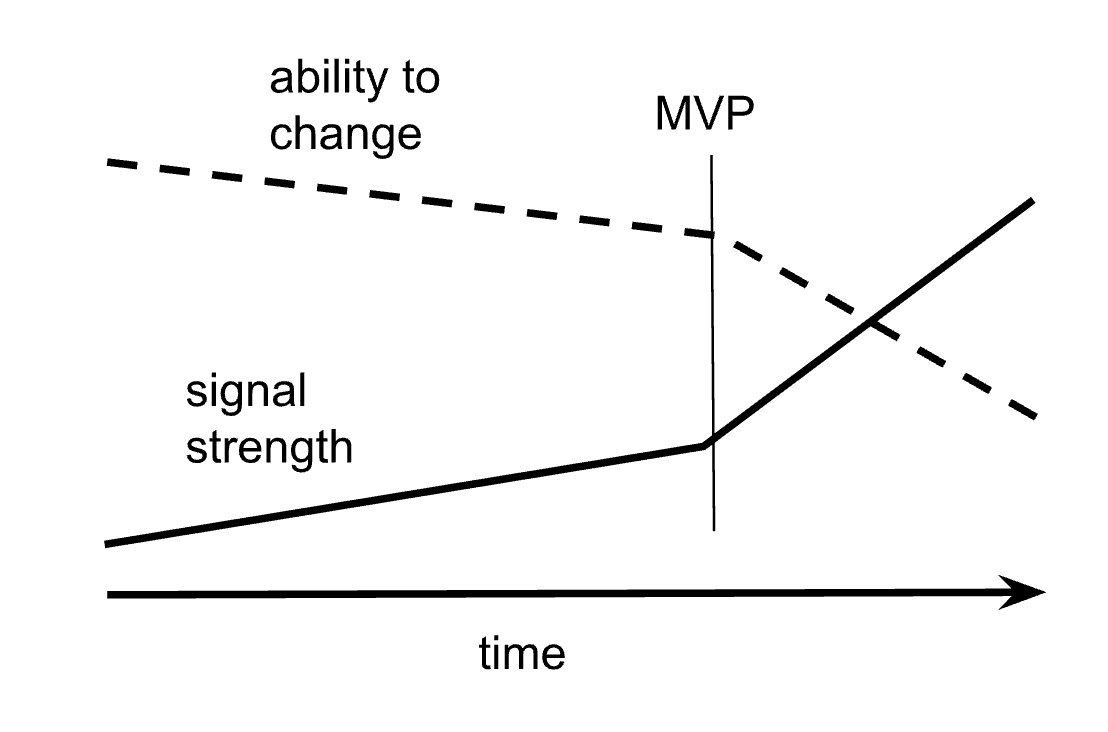Introduction
Defining and launching a product successfully without making at least some changes during the product development lifecycle is rare. Or, more likely – product leaders who are willing and able to adapt their product plans as they gather feedback during product definition and execution are more likely to succeed.
Product Market Fit (PMF) is used to assess whether an offering has found its place in the market (i.e., solves real problems users have) and can support a sustainable business.
PMF isn’t just a one-time check – it is something you must do continuously, even after you have shipped a product and have seen some success. User needs rarely stay static, and successful products and companies see the signals of change and adapt.
The Stages of Product Market Fit
The sooner you can determine good PMF, the sooner you will have the confidence to invest and build. Unfortunately, the PMF signals start weak and strengthen only as you get closer to a released product.

Once you have made an initial product available to customers (Prototype, MVP, Beta), your signal strength increases significantly, but so does your cost and resistance to change.
Generally speaking, there are things you can and must do before you build the product and things you should do once you have shipped something to continuously monitor whether you are still relevant to the market.
Market Validation and Sizing
The first step is to validate that there is a market for the solution you are thinking of. If you’re doing something truly disruptive and creating a new market – this will involve talking with people you believe have the problem you are trying to solve – you are trying to validate a concept. You will also need to size this market to understand the potential or TAM (Total Addressable Market) to determine if there’s a real business in solving the problem.
If you are not a true market-maker (more common), it will be much easier to determine the market potential – you may have established competitors, open source projects, or industry consensus that will validate the market need and potential size.
Pre-product
Once you understand the market and the personas involved (users, buyers, influencers), you can start to validate whether your proposed solution and its USP (Unique Selling Points) will address the market need. That validation will likely consist of one or more of the following with increasing fidelity:
- User/customer feedback on concepts
- Testing the USP and Value Proposition with users/customers
- Formal testing with wireframes, early prototypes, etc.
- Canned demos to start explaining some of the behavior to users
- Pre-GA releases – the sooner you can get the working product (in some state) into the end users’ hands – the better.
The challenge at this stage is finding the right users/personas willing to commit time and provide feedback – incentives (service credits, free access to the final product, etc) may help.
During this stage, you will likely learn more about your target users and may even have to re-consider your target personas in light of what you learn. The feedback you receive may also require you to change how you talk about the product and may need to refine and refocus your USPs.
Post-product
As I mentioned at the top of the article – the PMF signals get stronger the closer you get to a released product, and until the user can try the product in-context you may still need some critical validation. There are many factors aside from the core product that can affect user acceptance and validation:
- Price – you may have validated PMF in the context of a free offering. Putting a price on something changes how the user thinks about the product.
- Form – you may have validated the offering as a standalone feature (vs embedded as part of a platform) or a software vs service or dedicated hardware device.
- Availability – your procurement and onboarding process may add additional friction unacceptable to your target user/buyer.
- Market Access – you may have engaged with some initial target users, but does your salesforce/ sales channel give you access to the market you need?
Just because you have shipped a product and found at least some success validating PMF – don’t stop listening to the market and your customers/users. This is where tools like NPS or The 40% rule (aka Ellis Test) can be helpful to ensure your offering and the market aren’t diverging over time.
Who is responsible for assessing PMF?
Determining PMF is a team sport. It likely starts with and is spearheaded by Product Management and Product Marketing during discovery and development but will ultimately require support from User Research, Sales, Customer Success, and other groups in the organization.
Ongoing assessment of market fit will come through your Customer Sucess or Growth teams as they constantly monitor the performance of the product (NPS, Rule of 40%) and ultimately, your sales, sales-ops, and finance team looking at signals such as ARR growth, LTV (Lifetime Value) to CAC (Customer Acquisition Cost) ratio. Note – revenue or revenue-based derivatives may be good measures of PMF but it happens way too late in the product lifecycle to be use exclusively.
Conclusion
Shipping any product or even substantial features without validation during discovery and development is highly risky and will likely result in expsnive and disruptive pivots.
The PMF signals strengthen as you get closer to a released product, but you should still start as early as possible with customer/user sessions around concepts, ideas, and USPs because the costs of changing your focus and product plans increase substantially once you have released something to the market.